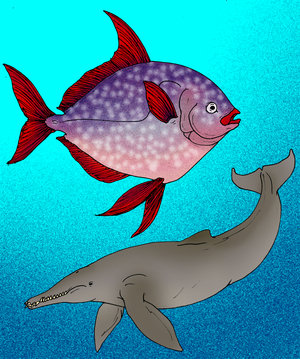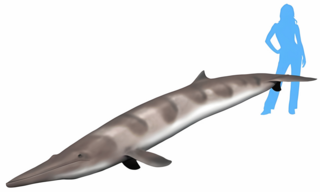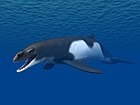
Neobalaenidae is a family of baleen whales including the extant pygmy right whale. Although traditionally considered related to balaenids, recent studies by Fordyce and Marx (2013) and Ludovic Dutoit and colleagues (2023) have recovered the living pygmy right whale as a member of Cetotheriidae, making it the only extant cetotheriid. Not all authors agree with this placement.

Prosqualodon is an extinct genus of Early to Middle Miocene cetacean from Argentina, Australia, New Zealand and Venezuela.
Mammalodon is an extinct genus of archaic baleen whale belonging to the family Mammalodontidae.

Waipatia is an extinct genus of odontocetes from the late Oligocene (Chattian) of New Zealand.

Cetotheriidae is a family of baleen whales. The family is known to have existed from the Late Oligocene to the Early Pleistocene before going extinct. Although some phylogenetic studies conducted by Fordyce & Marx 2013 recovered the living pygmy right whale as a member of Cetotheriidae, making the pygmy right whale the only living cetotheriid, other authors either dispute this placement or recover Neobalaenidae as a sister group to Cetotheriidae.
The Kokoamu Greensand is a geological formation found in New Zealand. It is a fossil-bearing, late Oligocene, greensand rock unit of the eastern South Island, especially the Waitaki District of North Otago and the southern Canterbury region. The formation was named by geologist Maxwell Gage in the 1950s. In North Otago it underlies the thicker and harder Otekaike Limestone. The formation gets its green colour from the mineral glauconite which forms slowly on the ocean floor.

Herpetocetus is a genus of cetotheriid mysticete in the subfamily Herpetocetinae. Considerably smaller than modern baleen whales, Herpetocetus measured only 3 to 4 meters in length. Additionally, due to the structure of its jaw, it was unable to open its mouth as wide as modern baleen whales, making it incapable of lunge feeding.
Peripolocetus is a genus of balaenid baleen whale from the middle Miocene of Kern County, California.
Eomysticetus is an extinct genus of baleen whale from the late Oligocene (Chattian) Chandler Bridge Formation of South Carolina.
The Alsea Formation is a geologic formation in Oregon. It preserves fossils dating back to the Rupelian stage of the Oligocene period.
Tohoraata is a genus of eomysticetid baleen whale from the Late Oligocene (Chattian) of New Zealand. There are two recognized species, T. raekohao and T. waitakiensis.
Eomysticetidae is a family of extinct mysticetes belonging to Chaeomysticeti. It is one of two families in the basal chaeomysticete clade Eomysticetoidea.
Tokarahia is a genus of eomysticetid baleen whale from the Late Oligocene (Chattian) of New Zealand. There are two recognized species, T. kauaeroa and T. lophocephalus.

Waharoa is a genus of eomysticetid baleen whale from the Late Oligocene (Chattian) of New Zealand. It was identified with the discovery of Waharoa ruwhenua by Boessenecker and Fordyce (2015), which added a new genus and species to a monophyletic family Eomysticetidae.
Matapanui is a genus of eomysticetid baleen whale from the Late Oligocene Kokoamu Greensand of New Zealand.

Horopeta is a genus of baleen whale from the Late Oligocene (Chattian) Kokoamu Greensand of New Zealand.
Whakakai is a genus of baleen whale from the Late Oligocene (Chattian) Kokoamu Greensand of New Zealand.
Toipahautea is a genus of baleen whale from the Late Oligocene (Chattian) Kokoamu Greensand of New Zealand.

Tangaroasaurus is an extinct genus of squalodontid whale from the Miocene of New Zealand. It contains a single species, Tangaroasaurus kakanuiensis. Similar to Basilosaurus and its close relative Squalodon, it was originally thought to be a species of marine reptile. Parts of the Holotype are presumably lost. Its name comes from Tangaroa, the Māori god of the sea, while the suffix -saurus comes from the Latin word for reptile, the group that Tangaroasaurus was originally placed in.











